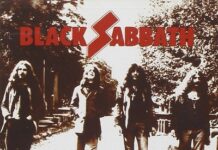The Birds, The Bees & The Monkees is the fifth studio release from the manufactured band created especially for TV. At this point, however, the show was on its last legs and the “band” was angling to seize more control over the music. That came with both good and bad consequences. They’d already broken ties with Don Kirshner after their smash second album. Both Headquarters and Pisces, Aquarius, Capricorn & Jones Ltd., number three and four, respectively, found Mike Nesmith, Peter Tork, Micky Dolenz and Davy Jones singing and playing together on many of the songs. Their records still scaled the charts, but something was amiss. The Monkees wanted to sit in the producer’s chair.
Rhino has done wonders with the Monkees catalog over the years, but the Handmade version of The Birds, The Bees & The Monkees — a triple-CD box set featuring mono and stereo mixes of the album plus dozens of rare and unreleased tracks (88 tracks total!) — may be the crown jewel of the ball. If you really want to get down to the brass tacks of where the Monkees were musically, spiritually, and personally at this crucial point in their storied career, you couldn’t get a better history lesson. Encased in replicated cover art and topped off with an informative essay, penned by Andrew Sandoval, this is something any avid Monkees fan shouldn’t be without.
One passage in the liner notes that rings true is that in early 1968, when The Birds, The Bees & The Monkees was recorded, the Monkees had entered what’s described as their own “White Album” phase several months before the Beatles. Despite the joint production credit for the album, the four principals only appear one song together — the Number 1 hit, “Daydream Believer,” recorded in the summer 1967 with Chip Douglas producing. The other songs featuring Davy Jones — the schmaltzy “Dream World,“ the drippy “We Were Made For Each Other,” the moderately enjoyable “The Poster,” and the group’s last Top 10 single, “Valleri” — were sustained by a cadre of session mavericks like Wrecking Crew drummer Hal Blaine, and apparently loads of woodwinds and string musicians.
Michael Nesmith, of course, went full throttle and added more than a few eclectic ideas to the mix. He had Micky Dolenz sing the country-laced “Auntie’s Municipal Court,” but took over on “Tapioca Tundra,” the album’s third single, going to 34 on the Top 40. Nesmith must have been plying the demons before working out the happily misplaced “Writing Wrongs,” a Neil Young-like primal exercise in heroic fortitude and self-righteousness. How it made the cut is a tribute to the wool-headed Texan’s power within the band. Too bad “Magnolia Simms,” in all its nostalgic charm, wasn’t up to the challenge.
Dolenz, whose voice graced most of the Monkees’ biggest hits, was dealt a neutral hand when it came to the songs he sang on The Birds, The Bees And The Monkees. Surely, “I’ll Be Back Up On My Feet” isn’t going to be remembered as a classic Monkees song, nor will “Zor And Zam,” despite its anti-war sentiment. “P.O. Box 9847,” written by Tommy Boyce and Bobby Hart, the duo behind many of the Monkees’ earlier songs as well as “Valleri,” had a fighting chance. Adding a marxophone and other psychedelic embellishments was certainly a step in the right direction, providing the kind of hippy street cred the Monkees needed to hang with the likes of the Beatles and Jimi Hendrix.
The voice or songs of Peter Tork didn’t make the final cut of the original 12-track disc. As part of the extras, however, Tork gets his due and then some. An alternate mix of “Long Title: Do I Have To Do This All Over Again” digs in deep with the Buffalo Springfield’s guitarist Stephen Stills and drummer Dewey Martin. Stills and drummer Buddy Miles also play on one version of Tork’s “Lady’s Baby” (Martin appears on the other versions).
A fascinating aspect of the Monkees uncovered by the selection of bonus tracks is that some of the songs were tracked with different lead vocalists. Nesmith’s “My Share Of The Sidewalk,” never released during the band’s run in the 60s, features both Jones and Nesmith leading the way, while versions of Tork’s “Tear The Top Right Off My Head” have Dolenz and Tork at the microphone. With all the egos crowding for space, Nesmith and Tork at least had the good sense to utilize the band’s more prominent singers to bring out the best in their songs.
Amidst the multiple alternates and stereo and mono mixes are shining examples of how the Monkees, through the self-indulgent chest-beating, still had a few gems hidden away for safekeeping. “Through The Looking Glass,” another Boyce and Hart song recorded at the end of 1967, wouldn’t surface until 1969, when the Monkees, reduced to a trio without Tork, threw it on as the opening number to Instant Replay. Had it been issued two years earlier, it likely would have charted.
You could spend a lifetime deciphering the motivation behind the quirky detours the Monkees were taking during the making of The Birds, The Bees & The Monkees. They did, in many ways, become a real band with real band issues that contributed largely to their demise. Nesmith and Tork staked their hearts in country and folk: Dolenz and Jones were actors who became rock stars, mixing vaudeville with rock and roll but unable to take it any further.
Nesmith’s talent would gain momentum, even earning him a Grammy in 1981 for a then-pioneering music video. The Monkees, in various incarnations, would turn up on the revival circuit; but in recent years, have gained significance as a pop artifact with a colorful history worthy of books, films and expanded CD sets like The Birds, The Bees & The Monkees. Not a bad legacy for a group never intended to outlive the sitcom from which they were created.
~ Shawn Perry




















